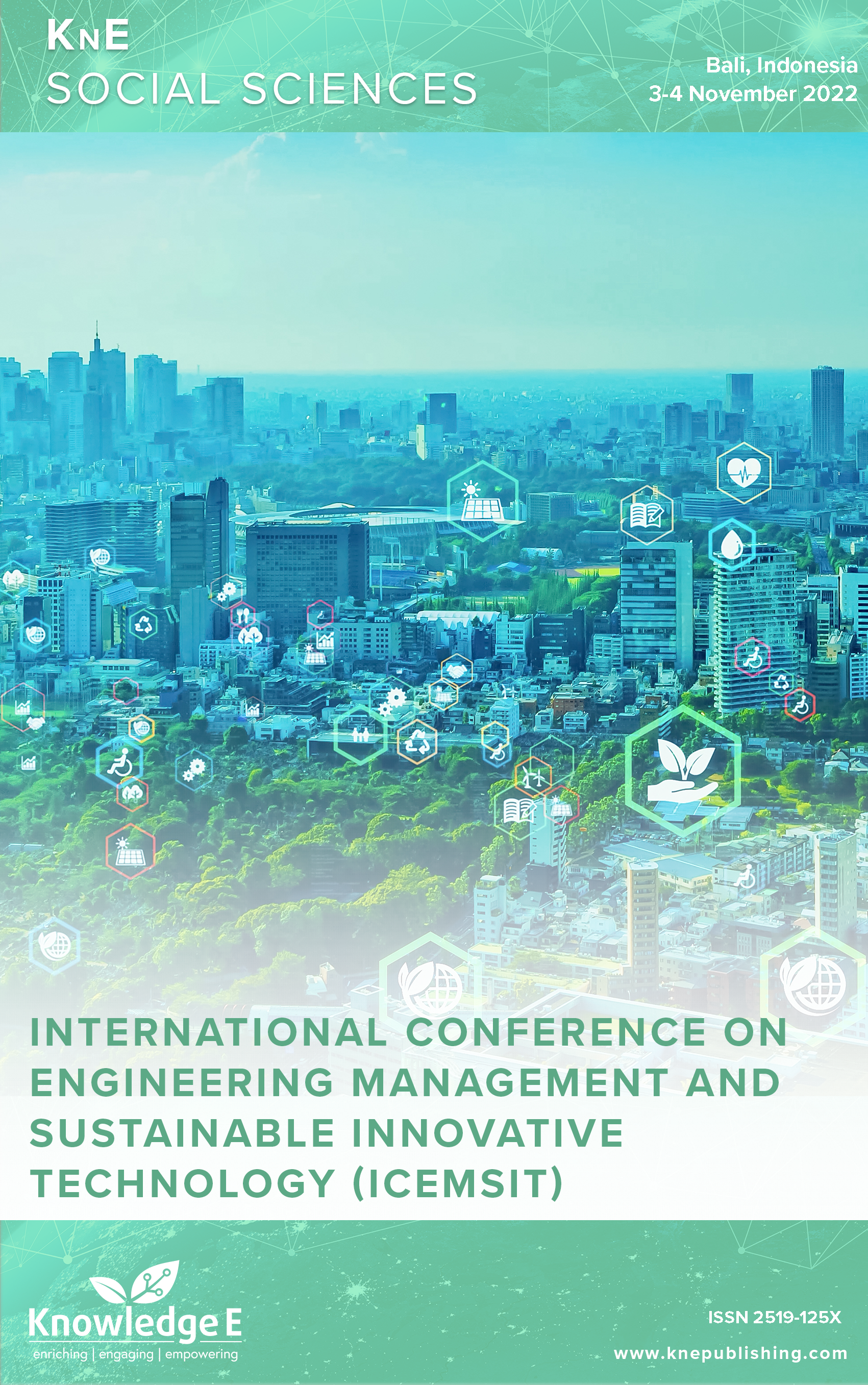The Phenomenon of Informal Workers in Housing Projects During the COVID-19 Pandemic
DOI:
https://doi.org/10.18502/kss.v9i10.15691Abstract
The COVID-19 pandemic influenced alterations in the real estate market. Since the pandemic, housing development in Indonesia has been negatively impacted, especially labor, which was crucial to the success of housing development. In addition, most workers in housing developments are informal workers who behave differently than formal or permanent workers. This study aimed to examine the phenomena of informal workers in housing developments during the COVID-19 pandemic using qualitative phenomenological approaches. Ten informal worker informants, five project supervisor in-formants, and two housing developer informants were chosen for in-depth interviews based on a preset criteria. In housing construction projects, implementing the health protocol and compliance with Occupational Health and Safety rules increased the awareness of informal workers. The fact that informal laborers prioritize health and safety during the COVID-19 outbreak is encouraging for building developers. Thus, the risk of housing construction projects decreases, and it is hoped that the government’s program to build one million homes will be successful. In addition, the government can create incentive-related policies for informal employees who implemented the health protocol during the COVID-19 outbreak.
Keywords: COVID-19, health and safety, housing project, informal workers
References
Rahma A. 11 Juta Rumah Tangga Belum Miliki Hunian Layak. Liputan6.Com. (Online). 2021. Available from: https://www.liputan6.com/bisnis/read/4486416/11-juta-rumahtangga- belum-miliki-hunian-layak
Ramadhan A, Kementerian PU. pembangunan perumahan tetap berjalan meski pandemi. Antara. (Online). 2021. Available from: https://www.antaranews.com/ berita/2289218/kementerian-pupr-pembangunan-perumahan-tetap-berjalanmeski- pandemi
Wijayaningtyas M, Redjo RE, Handoko F, Lukiyanto K, Jiram WR. The Millennials’ Energy Efficiency Behaviour towards Eco-friendly Home. Civil Engineering and Architecture. 2021;9:394–403. DOI: https://doi.org/10.13189/cea.2021.090212
Fadli A. Stimulus Pemerintah, Penggerak Utama Sektor Properti Kuartal II-2021. Kompas.Com. (Online) Available from: https://www.kompas.com/properti/read/2021/ 07/28/210000121/stimulus-pemerintah-penggerak-utama-sektor-properti-kuartal-ii- 2021?page=all
Sandi F. Sisa 4 Bulan, Program Sejuta Rumah Jokowi Baru 634.742 Unit. CNBC Indonesia. (Online). 2021. Available from: https://www.cnbcindonesia.com/news/ 20210831184232-4-272693/sisa-4-bulan-program-sejuta-rumah-jokowi-baru- 634742-unit
Petriella Y. Pengembang Diproyeksi Fokus pada Proyek Rumah Tapak. Bisnis.Com. 2021. https://ekonomi.bisnis.com/read/20210210/47/1354975/2021-pengembangdiproyeksi- fokus-pada-proyek-rumah-tapak
Triyawan A, Fendayanti ZE. Dampak pandemi covid-19 terhadap keberlangsungan perusahaan jasa konstruksi. Forum Ekonomi. 2021;23:223–30.
Wijayaningtyas M, Sipan I, Lukiyanto K. Informal worker phenomenon in housing construction project. Proceedings of the 3rd International Conference on Construction and Building Engineering (ICONBUILD). AIP Conference Proceedings; 2017. 1–7. DOI: https://doi.org/10.1063/1.5011575
Lukiyanto K, Wijayaningtyas M. Marketing strategy for informal worker group in construction industry in Indonesia. Management and Economics Journal. 2017;1:35– 48. DOI: https://doi.org/10.18860/mec-j.v1i1.4576
Lukiyanto K. Leadership style that effective and capable to increase performance based on informal workers perception (case study on Indonesia construction project) [IJCIET]. International Journal of Civil Engineering and Technology. 2018;9:850–60.
Laksmana DI, Wijayaningtyas M. Integration facility management: human resources. International Journal of Scientific and Technology Research. 2019;8:701–5.
Elphiana EG, Diah YM, Zen MK, Pengaruh keselamatan dan kesehatan kerja terhadap kinerja karyawan PT. pertamina ep asset 2 prabumulih, Jurnal Ilmiah Manajemen Bisnis dan Terapan. 2017;2:103–118. DOI: https://doi.org/10.36805/manajemen.v2i1.162
Gopalakrishnan G, Brindha G. A study on employee welfare in the construction industry. International Journal of Civil Engineering and Technology. 2017;8:7–12.
Khurana S. Resisting labour control and optimizing social ties: experiences of women construction workers in Delhi. Work Employ Soc. 2017;31(6):921–36. DOI: https://doi.org/10.1177/0950017016651396
Wijayaningtyas M, Lukiyanto K. Informal housing construction workers’ perceptions toward the improvement of effective leadership and performance, MATEC Web of Conferences, 2019. DOI: https://doi.org/10.1051/matecconf/201925802004
Azmi WF, Misnan MS. Stakeholders’ Attitude Towards Construction Workers’ Safety and Health. J Eng Appl Sci (Asian Res Publ Netw). 2018;13:6950–3.
Creswell J, Plano Clark V. Designing and Conducting Mixed Methods Research. Thousand Oaks (CA): Sage; 2017.
Koch LC, Niesz T, McCarthy H. Understanding and reporting qualitative research: an analytical review and recommendations for submitting authors. Rehabil Couns Bull. 2014;57(3):131–43. DOI: https://doi.org/10.1177/0034355213502549
Creswell JW. Research Design: Qualitative, Quantitative and Mixed Methods Approaches. 4th ed. Sage Publisher; 2014.
Creswell JW, Poth CN. Qualitative inquiry and research design: Choosing among five traditions. Sage Publications Inc; 2017.
Lukiyanto K, Wijayaningtyas M. Gotong Royong as social capital to overcome micro and small enterprises’ capital difficulties. Heliyon. 2020 Sep;6(9):e04879. DOI: https://doi.org/10.1016/j.heliyon.2020.e04879
Handoko F, Wijayaningtyas M, Kusuma IH, Hidayat S, Ismail A, Abdullah Z. The occupational health and safety effect on road construction worker performance. Civil Engineering and Architecture. 2020;8(5):750–9. DOI: https://doi.org/10.13189/cea.2020.080502
Jaiswal A. Occupational Health and Safety in the Construction Industry in Developing Countries Scanned by CamScanner. 2018.
Zahra AN, Kurniawidjaja LM. Construction Workers’ Fatigue Conditions at PT. X Construction Contractor Apartment Development in the 2017 Work Year, KnE. Life Sci. 2018;4:46. DOI: https://doi.org/10.18502/kls.v4i5.2538

